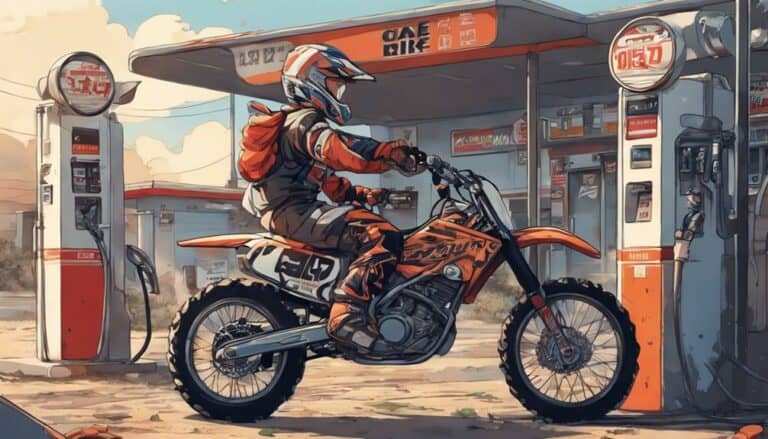Do you ever wonder what kind of gas is suitable for your dirt bike? Understanding the fuel requirements of your dirt bike is important for its performance and longevity.
Different models may have specific fuel needs, and using the wrong type could potentially damage your bike. Let's explore the various types of fuel that dirt bikes can use and how to determine the best option for your specific ride.
Key Takeaways
- Dirt bikes require specific unleaded gasoline meeting manufacturer's specifications.
- Ethanol content should not exceed 10% to prevent engine damage.
- Regular gas without oil can cause friction-induced damage in 2-stroke engines.
- Higher octane fuels like 110-octane race fuel optimize power output and performance.
Types of Fuel for Dirt Bikes
When selecting fuel for your dirt bike, make sure it meets the manufacturer's specifications for best performance and engine longevity. Dirt bikes typically run on unleaded gasoline without lead to optimize engine performance. Some models may require a specific gasoline-oil mixture or ethanol-based fuel as indicated in the owner's manual. It's important to understand the fuel requirements of your dirt bike as using the wrong type can result in engine damage and decreased performance.
The type of fuel your dirt bike needs depends on factors like the engine design and the recommendations provided by the manufacturer. Ensuring that you use the correct octane rating is essential for proper combustion and overall engine health. Always refer to the owner's manual for precise instructions on the fuel type and octane requirements for your specific dirt bike model. By following these guidelines, you can maintain the efficiency and longevity of your dirt bike's engine, allowing you to enjoy the best performance on your rides.
Ethanol Compatibility With Dirt Bikes
Ethanol compatibility with dirt bikes varies based on the type of engine and its components, influencing performance and long-term durability. While ethanol can enhance performance in 4-stroke dirt bikes, its presence can lead to severe issues with 2-stroke bikes. The breakdown of oil in the fuel mix due to high ethanol content can cause damage over time, necessitating caution to prevent long-term damage.
Ethanol-based fuels have a tendency to attract moisture, leading to engine corrosion, particularly affecting aluminum and rubber parts. To mitigate the risk of engine corrosion and guarantee top-notch dirt bike performance, it's advised to steer clear of ethanol concentrations exceeding 10%. Choosing fuels with lower or zero ethanol content is critical for maintaining the integrity of the engine and preventing any potential long-term damage that could compromise the bike's overall functionality and longevity.
Impact of Regular Gas on 2-Stroke Bikes
Regular gas can have detrimental effects on 2-stroke bikes due to the lack of oil for proper lubrication, causing wear and tear that can lead to significant engine damage over time. When using regular gas in 2-stroke engines, be aware of the following:
- Lack of Lubrication: Regular gas lacks the necessary oil content, leading to increased friction within the engine components.
- Friction-Induced Damage: The absence of oil in regular gas can result in scoring on the cylinder walls and piston, accelerating wear and tear.
- Compression Loss: Continuous use of regular gas in 2-stroke bikes can lead to compression loss due to increased friction and lack of proper lubrication.
- Engine Shutdown: Over time, the wear and tear caused by regular gas can be severe enough to cause engine shutdown, necessitating costly repairs.
To prevent these issues, ascertain that 2-stroke engines receive the appropriate oil mix in the fuel to maintain proper lubrication and prevent damage from the use of regular gas.
Using 110-Octane in Dirt Bikes
Switching to 110-octane race fuel for your dirt bike can greatly enhance its performance without directly impacting its speed. Higher octane fuels like 110-octane are commonly referred to as race fuels for dirt bikes. While most dirt bike engines typically run well on 93 octane fuel, utilizing 110-octane race fuel with oxygen additives can further optimize the bike's power output.
The added oxygen in higher octane fuels allows for more efficient combustion, resulting in increased performance levels. By incorporating 110-octane fuel into your dirt bike, you can experience enhanced throttle response, improved acceleration, and overall better engine efficiency.
It's essential to note that the benefits of using 110-octane race fuel go beyond just power enhancement; they also contribute to maintaining the engine's cleanliness and longevity. So, for dirt bike enthusiasts looking to maximize their bike's performance, switching to 110-octane fuel can be a game-changer in achieving best results.
Suitability of E85 for Dirt Bikes
Considering the unique properties of E85 fuel, it's essential for dirt bike riders to evaluate its suitability for their machines before incorporating it into their fuel choices. Here are four key points to keep in mind:
- Power Boost: E85 fuel, with its 85% ethanol content, can offer a 1-2% power boost for dirt bikes, potentially enhancing performance on the track or trail.
- Rejetting Requirement: Due to E85's different combustion properties compared to traditional gasoline, dirt bike riders using E85 will need to engage in frequent rejetting to optimize engine performance and fuel efficiency.
- Corrosion Concerns: The high ethanol content in E85 can lead to corrosion of aluminum and rubber parts in dirt bikes over time, necessitating careful inspection and maintenance routines.
- Caution and Maintenance: While E85 can provide a power boost, riders must exercise caution and adhere to a rigorous maintenance schedule to mitigate potential damage caused by the corrosive nature of ethanol on various parts of the bike.
Conclusion
You may want to contemplate exploring alternative fuel options for your dirt bike to enhance its performance and longevity.
It's advisable to consult your owner's manual and contemplate the specific requirements of your bike before refueling.
Making informed decisions about the type of fuel you use can contribute to a smoother riding experience and potentially extend the life of your bike.

